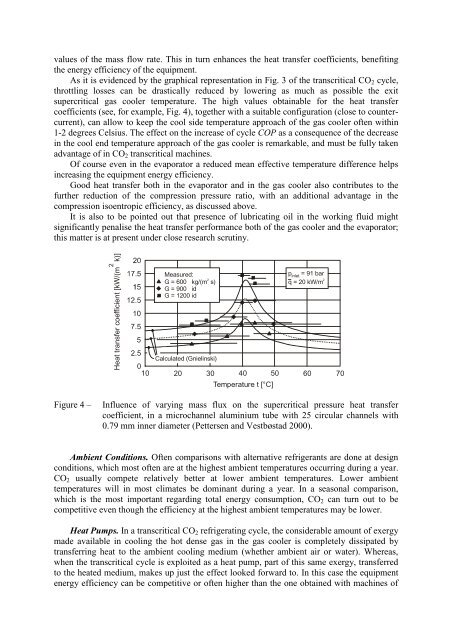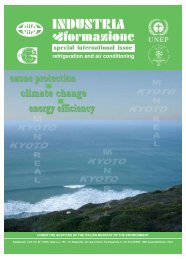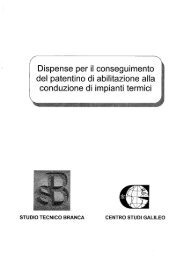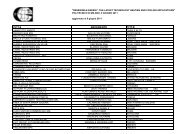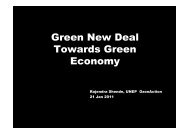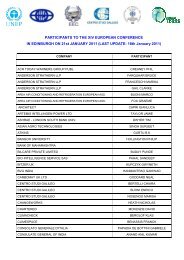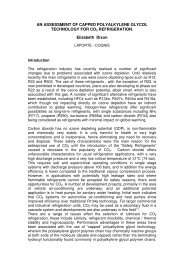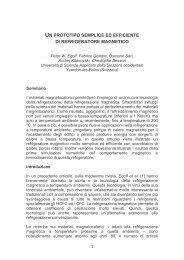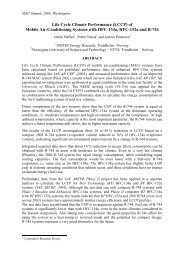PROPERTIES OF CO2 AS A REFRIGERANT - Centro Studi Galileo
PROPERTIES OF CO2 AS A REFRIGERANT - Centro Studi Galileo
PROPERTIES OF CO2 AS A REFRIGERANT - Centro Studi Galileo
Create successful ePaper yourself
Turn your PDF publications into a flip-book with our unique Google optimized e-Paper software.
values of the mass flow rate. This in turn enhances the heat transfer coefficients, benefiting<br />
the energy efficiency of the equipment.<br />
As it is evidenced by the graphical representation in Fig. 3 of the transcritical CO 2 cycle,<br />
throttling losses can be drastically reduced by lowering as much as possible the exit<br />
supercritical gas cooler temperature. The high values obtainable for the heat transfer<br />
coefficients (see, for example, Fig. 4), together with a suitable configuration (close to countercurrent),<br />
can allow to keep the cool side temperature approach of the gas cooler often within<br />
1-2 degrees Celsius. The effect on the increase of cycle COP as a consequence of the decrease<br />
in the cool end temperature approach of the gas cooler is remarkable, and must be fully taken<br />
advantage of in CO 2 transcritical machines.<br />
Of course even in the evaporator a reduced mean effective temperature difference helps<br />
increasing the equipment energy efficiency.<br />
Good heat transfer both in the evaporator and in the gas cooler also contributes to the<br />
further reduction of the compression pressure ratio, with an additional advantage in the<br />
compression isoentropic efficiency, as discussed above.<br />
It is also to be pointed out that presence of lubricating oil in the working fluid might<br />
significantly penalise the heat transfer performance both of the gas cooler and the evaporator;<br />
this matter is at present under close research scrutiny.<br />
2<br />
Heat transfer coefficient [kW/(m k)]<br />
5<br />
Measured:<br />
2<br />
G = 600 kg/(m s)<br />
G = 900 id<br />
G = 1200 id<br />
2.5<br />
Calculated (Gnielinski)<br />
0<br />
10 20 30 40 50 60 70<br />
Temperature t [°C]<br />
p<br />
inlet<br />
= 91 bar<br />
2<br />
q = 20 kW/m<br />
Figure 4 –<br />
Influence of varying mass flux on the supercritical pressure heat transfer<br />
coefficient, in a microchannel aluminium tube with 25 circular channels with<br />
0.79 mm inner diameter (Pettersen and Vestbøstad 2000).<br />
Ambient Conditions. Often comparisons with alternative refrigerants are done at design<br />
conditions, which most often are at the highest ambient temperatures occurring during a year.<br />
CO 2 usually compete relatively better at lower ambient temperatures. Lower ambient<br />
temperatures will in most climates be dominant during a year. In a seasonal comparison,<br />
which is the most important regarding total energy consumption, CO 2 can turn out to be<br />
competitive even though the efficiency at the highest ambient temperatures may be lower.<br />
Heat Pumps. In a transcritical CO 2 refrigerating cycle, the considerable amount of exergy<br />
made available in cooling the hot dense gas in the gas cooler is completely dissipated by<br />
transferring heat to the ambient cooling medium (whether ambient air or water). Whereas,<br />
when the transcritical cycle is exploited as a heat pump, part of this same exergy, transferred<br />
to the heated medium, makes up just the effect looked forward to. In this case the equipment<br />
energy efficiency can be competitive or often higher than the one obtained with machines of


